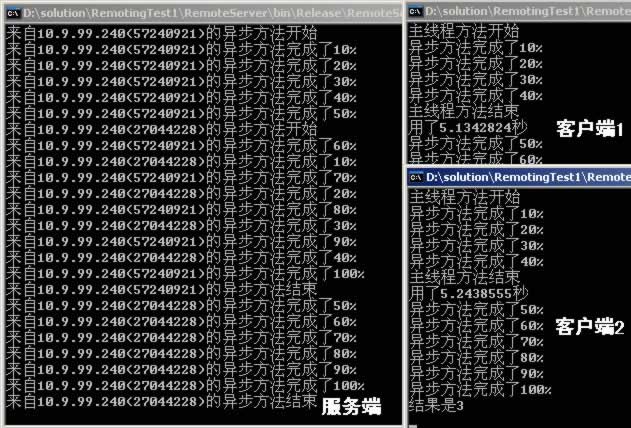(原创)一步一步学Remoting之六:事件(2)
(原创)一步一步学Remoting之六:事件(2)
到了午休的时间,抓紧时间继续写,上次说有2个遗留问题:
(1)关闭一个客户端以后会影响其他的客户端事件
原因:客户端没有取消事件订阅就关闭了,触发事件的时候找不到事件订阅者
解决:遍历委托链,找到异常的对象,从委托链中卸下
(2)服务器端对客户端广播,客户端能收到其他客户端的事件处理信息
原因:使用了Singleton模式,共享远程对象
解决:因为需要远程对象有状态且不共享实例,所以只有客户端激活可以选择
修改后的服务端:
using System;
using System.Collections;
using System.Runtime.Remoting;
using System.Runtime.Remoting.Channels;
using System.Runtime.Remoting.Channels.Tcp;
using System.Runtime.Serialization.Formatters;
namespace RemoteServer
{
class MyServer
{
[STAThread]
static void Main(string[] args)
{
RemotingConfiguration.ApplicationName="RemoteObject.MyObject";
RemotingConfiguration.RegisterActivatedServiceType(typeof(RemoteObject.MyObject));
BinaryServerFormatterSinkProvider serverProvider = new BinaryServerFormatterSinkProvider();
BinaryClientFormatterSinkProvider clientProvider = new BinaryClientFormatterSinkProvider();
serverProvider.TypeFilterLevel = TypeFilterLevel.Full;
IDictionary props = new Hashtable();
props["port"]=8888;
TcpChannel channel = new TcpChannel(props,clientProvider,serverProvider);
ChannelServices.RegisterChannel(channel);
Console.ReadLine();
}
}
}
using System.Collections;
using System.Runtime.Remoting;
using System.Runtime.Remoting.Channels;
using System.Runtime.Remoting.Channels.Tcp;
using System.Runtime.Serialization.Formatters;
namespace RemoteServer
{
class MyServer
{
[STAThread]
static void Main(string[] args)
{
RemotingConfiguration.ApplicationName="RemoteObject.MyObject";
RemotingConfiguration.RegisterActivatedServiceType(typeof(RemoteObject.MyObject));
BinaryServerFormatterSinkProvider serverProvider = new BinaryServerFormatterSinkProvider();
BinaryClientFormatterSinkProvider clientProvider = new BinaryClientFormatterSinkProvider();
serverProvider.TypeFilterLevel = TypeFilterLevel.Full;
IDictionary props = new Hashtable();
props["port"]=8888;
TcpChannel channel = new TcpChannel(props,clientProvider,serverProvider);
ChannelServices.RegisterChannel(channel);
Console.ReadLine();
}
}
}
修改后的远程对象:
using System;
namespace RemoteObject
{
[Serializable]
public class MyEventArgs:EventArgs
{
private int _rate;
private string _ip;
public int Rate
{
get
{
return _rate;
}
}
public string IP
{
get
{
return _ip;
}
}
public MyEventArgs(int rate,string ip)
{
this._rate=rate;
this._ip=ip;
}
}
public class MyObject:MarshalByRefObject
{
public delegate void MyEventHandler(object sender,MyEventArgs e);
public event MyEventHandler MyEvent;
public string tmp;
public int ALongTimeMethod(int a,int b,int time,string ip)
{
Console.WriteLine("来自"+ip+"的异步方法开始");
for(int i=1;i<=10;i++)
{
System.Threading.Thread.Sleep(time);
Console.WriteLine("来自"+ip+"的异步方法完成了"+i*10+"%");
OnMyEvent(new MyEventArgs(i,ip));
}
Console.WriteLine("来自"+ip+"的异步方法结束");
return a+b;
}
protected void OnMyEvent(MyEventArgs e)
{
if (MyEvent!=null)
{
foreach(Delegate d in MyEvent.GetInvocationList())
{
try
{
((MyEventHandler)d)(this,e);
}
catch
{
MyEvent-=(MyEventHandler)d;
}
}
}
}
}
public class EventClass:MarshalByRefObject
{
public void MyEvent(object sender,MyEventArgs e)
{
if(((MyObject)sender).tmp==e.IP)
Console.WriteLine("异步方法完成了"+e.Rate*10+"%");
}
}
}
namespace RemoteObject
{
[Serializable]
public class MyEventArgs:EventArgs
{
private int _rate;
private string _ip;
public int Rate
{
get
{
return _rate;
}
}
public string IP
{
get
{
return _ip;
}
}
public MyEventArgs(int rate,string ip)
{
this._rate=rate;
this._ip=ip;
}
}
public class MyObject:MarshalByRefObject
{
public delegate void MyEventHandler(object sender,MyEventArgs e);
public event MyEventHandler MyEvent;
public string tmp;
public int ALongTimeMethod(int a,int b,int time,string ip)
{
Console.WriteLine("来自"+ip+"的异步方法开始");
for(int i=1;i<=10;i++)
{
System.Threading.Thread.Sleep(time);
Console.WriteLine("来自"+ip+"的异步方法完成了"+i*10+"%");
OnMyEvent(new MyEventArgs(i,ip));
}
Console.WriteLine("来自"+ip+"的异步方法结束");
return a+b;
}
protected void OnMyEvent(MyEventArgs e)
{
if (MyEvent!=null)
{
foreach(Delegate d in MyEvent.GetInvocationList())
{
try
{
((MyEventHandler)d)(this,e);
}
catch
{
MyEvent-=(MyEventHandler)d;
}
}
}
}
}
public class EventClass:MarshalByRefObject
{
public void MyEvent(object sender,MyEventArgs e)
{
if(((MyObject)sender).tmp==e.IP)
Console.WriteLine("异步方法完成了"+e.Rate*10+"%");
}
}
}
修改后的客户端:
using System;
using System.Net;
using System.Collections;
using System.Text;
using System.Runtime.Remoting;
using System.Runtime.Remoting.Channels;
using System.Runtime.Remoting.Channels.Tcp;
using System.Runtime.Serialization.Formatters;
class MyClient
{
private delegate int MyDelegate(int a,int b,int time,string ip);
private static MyDelegate md;
static RemoteObject.MyObject app;
static RemoteObject.EventClass ec;
static DateTime dt;
[STAThread]
static void Main(string[] args)
{
dt=DateTime.Now;
RemotingConfiguration.RegisterActivatedClientType(typeof(RemoteObject.MyObject),"tcp://localhost:8888/RemoteObject.MyObject");
BinaryServerFormatterSinkProvider serverProvider = new BinaryServerFormatterSinkProvider();
BinaryClientFormatterSinkProvider clientProvider = new BinaryClientFormatterSinkProvider();
serverProvider.TypeFilterLevel = TypeFilterLevel.Full;
IDictionary props=new Hashtable();
props["port"]=0;
TcpChannel channel = new TcpChannel(props,clientProvider,serverProvider);
ChannelServices.RegisterChannel(channel);
app=new RemoteObject.MyObject();
ec=new RemoteObject.EventClass();
app.MyEvent+=new RemoteObject.MyObject.MyEventHandler(ec.MyEvent);
md=new MyDelegate(app.ALongTimeMethod);
AsyncCallback ac=new AsyncCallback(MyClient.CallBack);
IPHostEntry ipHE=Dns.GetHostByName(Dns.GetHostName());
Random rnd=new Random(System.Environment.TickCount);
string ip=ipHE.AddressList[0].ToString()+"("+rnd.Next(100000000).ToString()+")";
app.tmp=ip;
IAsyncResult Iar=md.BeginInvoke(1,2,500,ip,ac,null);
Method();
Console.WriteLine("用了"+((TimeSpan)(DateTime.Now-dt)).TotalSeconds+"秒");
ChannelServices.UnregisterChannel(channel);
Console.ReadLine();
}
public static void CallBack(IAsyncResult Iar)
{
if(Iar.IsCompleted)
{
Console.WriteLine("结果是"+md.EndInvoke(Iar));
app.MyEvent-=new RemoteObject.MyObject.MyEventHandler(ec.MyEvent);
}
}
public static void Method()
{
Console.WriteLine("主线程方法开始");
System.Threading.Thread.Sleep(5000);
Console.WriteLine("主线程方法结束");
}
}
using System.Net;
using System.Collections;
using System.Text;
using System.Runtime.Remoting;
using System.Runtime.Remoting.Channels;
using System.Runtime.Remoting.Channels.Tcp;
using System.Runtime.Serialization.Formatters;
class MyClient
{
private delegate int MyDelegate(int a,int b,int time,string ip);
private static MyDelegate md;
static RemoteObject.MyObject app;
static RemoteObject.EventClass ec;
static DateTime dt;
[STAThread]
static void Main(string[] args)
{
dt=DateTime.Now;
RemotingConfiguration.RegisterActivatedClientType(typeof(RemoteObject.MyObject),"tcp://localhost:8888/RemoteObject.MyObject");
BinaryServerFormatterSinkProvider serverProvider = new BinaryServerFormatterSinkProvider();
BinaryClientFormatterSinkProvider clientProvider = new BinaryClientFormatterSinkProvider();
serverProvider.TypeFilterLevel = TypeFilterLevel.Full;
IDictionary props=new Hashtable();
props["port"]=0;
TcpChannel channel = new TcpChannel(props,clientProvider,serverProvider);
ChannelServices.RegisterChannel(channel);
app=new RemoteObject.MyObject();
ec=new RemoteObject.EventClass();
app.MyEvent+=new RemoteObject.MyObject.MyEventHandler(ec.MyEvent);
md=new MyDelegate(app.ALongTimeMethod);
AsyncCallback ac=new AsyncCallback(MyClient.CallBack);
IPHostEntry ipHE=Dns.GetHostByName(Dns.GetHostName());
Random rnd=new Random(System.Environment.TickCount);
string ip=ipHE.AddressList[0].ToString()+"("+rnd.Next(100000000).ToString()+")";
app.tmp=ip;
IAsyncResult Iar=md.BeginInvoke(1,2,500,ip,ac,null);
Method();
Console.WriteLine("用了"+((TimeSpan)(DateTime.Now-dt)).TotalSeconds+"秒");
ChannelServices.UnregisterChannel(channel);
Console.ReadLine();
}
public static void CallBack(IAsyncResult Iar)
{
if(Iar.IsCompleted)
{
Console.WriteLine("结果是"+md.EndInvoke(Iar));
app.MyEvent-=new RemoteObject.MyObject.MyEventHandler(ec.MyEvent);
}
}
public static void Method()
{
Console.WriteLine("主线程方法开始");
System.Threading.Thread.Sleep(5000);
Console.WriteLine("主线程方法结束");
}
}
之所以要在ip地址后面跟上随机数,是因为可能在一个机器上会打开多个客户端,需要在这个时候能在服务器端区分多个客户端。

备注:我的所有例子都是在客户端和服务器端部署远程对象的,其实这个做法不是很好,我们应该仅仅把接口部署在两地,远程对象仅仅部署在服务器端即可。
欢迎大家阅读我的极客时间专栏《Java业务开发常见错误100例》【全面避坑+最佳实践=健壮代码】




 浙公网安备 33010602011771号
浙公网安备 33010602011771号